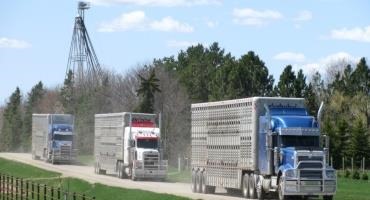Producers who have relocated their cattle out of state for winter feeding this year should consider having a weed management protocol in place when the cattle return, say North Dakota State University Extension specialists.

Cattle returning from out-of-state locations should be confined to one area for at least one week upon return to mitigate the spread of weed seeds.
“If you have sent your cattle to areas where there are known Palmer amaranth, waterhemp or other noxious or troublesome weed issues, it will be important to allow a ‘cleanout period’ upon return,” says Joe Ikley, NDSU Extension weed specialist. “Crop fields are not the preferred area for this period, since weeds like Palmer amaranth are generally more difficult to control in crops compared to bare ground, pastures or a corral.”
“The retention time of potential weed seeds in the gastrointestinal tract is heavily dependent on the digestibility of the diet,” says Zac Carlson, NDSU Extension beef cattle specialist. “When we turn cattle out to green, lush cover crop, the passage rate of that feed is high compared to lower digestible forages, such as prairie hay. That does not mean some seeds couldn’t get held up longer in the gastrointestinal tract.”
Mary Keena, NDSU Extension livestock environmental management specialist based at the Carrington Research Extension Center, suggests confining cattle to one area for at least one week upon return.
“The manure, which includes feces, bedding and spilled or uneaten feedstuffs, should be kept in that area and composted,” Keena advises. “Composting manure has been shown not only to reduce the volume of manure and kill parasites and pathogens, but also is an effective weed seed management strategy.”
“Piling manure and turning it five to six times every 10 to 14 days should achieve temperatures between 130-160 degrees Fahrenheit,” says Keena. “The high temperatures along with proper pile moisture will kill both large and small weed seeds.”
To learn more about composting manure, view the NDSU Extension publication, Composting Animal Manures: A Guide to the Process and Management of Animal Manure Compost at https://tinyurl.com/NDSUCompostingAnimalManures.
“Livestock owners will want to keep a close eye on the area where the manure is managed to make sure escaped weed seeds that grow in the spring and summer of 2022 are pulled and properly disposed of,” warns Ikley. “Before the plants develop seeds, pull and destroy them by burying them deeply or burning them.”
Keena adds, “If producers are going to spread the compost from that area, they will want to closely monitor the area where they spread it and practice similar monitoring and disposal techniques as in the feeding area.”
It is not recommended to spread fresh manure on fields if it is known to contain noxious or troublesome weeds. However, if producers need to graze before weeds seeds have been passed or if producers need to spread the fresh manure on a field, we recommend spreading weed seed-heavy manure on tame grass pastures or grass hayfields, because more options are available to control on them, says Miranda Meehan, NDSU Extension livestock environmental stewardship specialist.
“It is never recommended to spread manure on native rangeland,” says Meehan. “Adding additional nutrients can benefit invasive grass species such as Kentucky bluegrass and smooth brome.”
Source : ndsu.edu